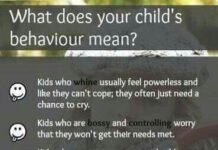Is there a lot of stress and strain in your life because your children just don’t listen?
Do you spend the majority of your waking moments chasing after your children because they are not listening to you, and you feel like you have to micro-manage?
Do you have no energy because all your energy is spent being frustrated and blocked by your children’s apparent inability to follow orders?
Well, the good news is you may be able to get back your time and energy and a balanced family life simply by understanding what the communication block is between you and your children.
Of course, every child is unique. Some children need their freedom more than others. Some children enjoy structure, and some do not. But what they all do have is one, two, three or four communication modalities or communication modes in common.
What is a communication modality or mode?
As Dr. Robby, Director of the LMC Relationship Centre, Developer of the Better Parents, Better Kids Program, and co-author of our e-book, Better Parents, Better Kids, explains:
“Communication is the result you get. Different people are on different channels. We learn, we express love and communicate through different modes or combinations of modes. It is important to know who you are playing with and what channel they are playing on, or else your communication will not be very effective. We basically all want to get what we want. If you cannot get your message through of what your needs, wants, dreams, goals and visions are, you will be very frustrated and stressed. So an understanding of communication modes is a basic skill for relationship success, whether that is a relationship with a partner, your children, friends, family or coworkers.”
The following is a very basic definition of the communication modes. You can be primarily one mode or a mixture of up to all four.
Visual people communicate by seeing and doing. They like activities and they like gifts. They notice people, places and things with just the slightest glance. They feel and share love by doing things with or for other people. They take things at face value and do not look deeper into things. They learn by seeing and doing.
Auditory people communicate through talking. They have the natural gift of the gab, are designed to be able to talk for long periods of time. They enjoy talking and listening to other people talk. They feel loved when they are talked to, and like to hear the words “I love you.” They learn by hearing.
Digital people communicate through connection and understanding. They find the deeper meaning in everything they think, see and do. Understanding is very important to them. They feel loved when they share connections with others and are understood. They learn by understanding.
Kinesthetic people communicate through their bodies. They move, feel and express through their bodies. Kinesthetics love to touch, feel, do physical activities and hug. They feel loved when they are touched. They learn through touch and through experience.
So children are not any different. If you are giving children orders or directions and they are not picking up your orders because they are in your own communication mode and not their own communication mode, they will genuinely not pick up or learn what you are trying to tell them or teach them. They are not being stubborn or defiant; they genuinely aren’t receiving it. It’s like you are talking on an AM radio station and your children are receiving on an FM radio station.
For example, my youngest son is a Visual child, and I used to have to repeatedly tell him to pick up his clothes and clean his room, but to him, my auditory orders were basically like the teacher’s on the Charlie Brown cartoons, just a series of muffled noises. But after learning about communication modes, I realized that if I really wanted to get across to him what I wanted, I had to show him what I wanted him to do, or do it with him, since a Visual child, just like Visual adults, likes doing things with you, as does a Kinesthetic child. The result is that now I never have to repeat myself with my son; he picks up and understands my visual cues.
For an Auditory child, if you are a Visual parent and you are showing your child how to clean and tidy up, it won’t have an impact on them unless you tell them what you want and/or narrate as you are doing it. This works for a Digital child as well, if you explain step by step what you are doing so they understand the whole process.
For a Kinesthetic child, let them do a run-through themselves, or let them hold on to or touch what it is that you are teaching or getting them to do. Kinesthetic children learn and remember through touch. Even though a Visual child likes doing, a Visual child can learn by just seeing and watching, whereas a Kinesthetic child has to go through the motions to truly learn.
There is a part of you (especially if you are Visual) saying, “Yeah, I’ll believe it when I see it.” There is also a part of you that is connecting the dots and saying, “Yeah, that makes sense, and that explains why my child does what they do that way.”
So go ahead and come up with creative ways to communicate with your children in their communication modes, and see, hear, understand and/or feel what happens. You may just get that time, energy and peace of mind that you have always wanted, as well as a balanced and happy family, too.










































